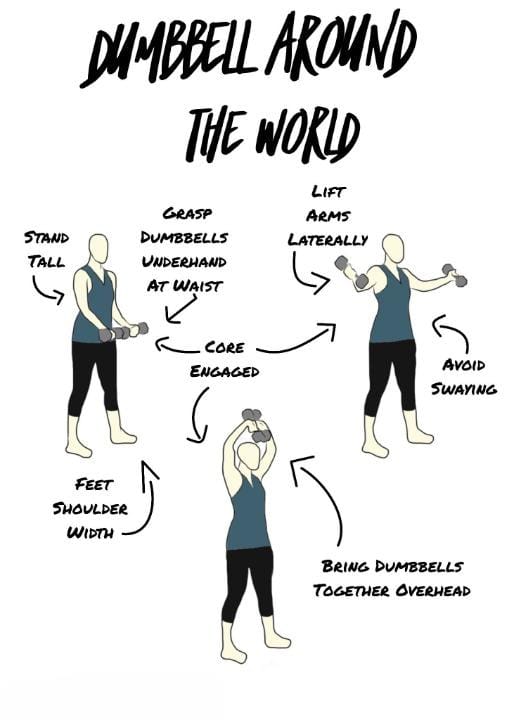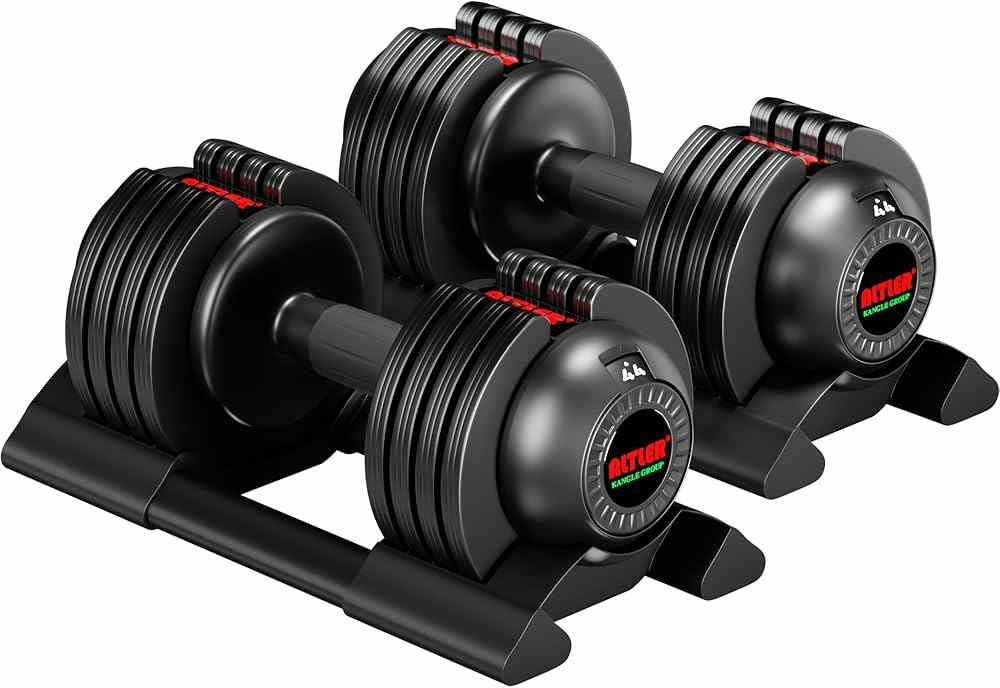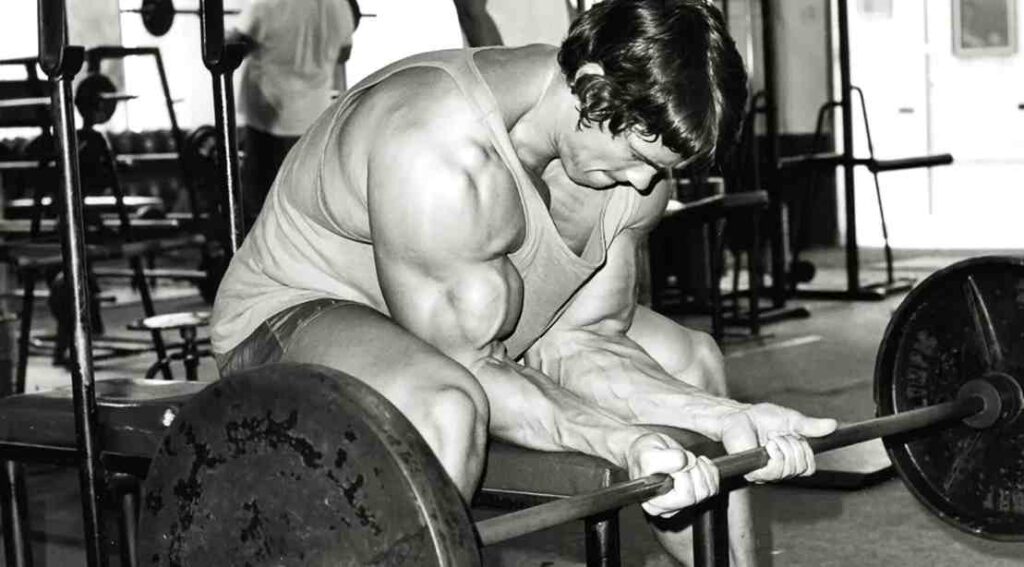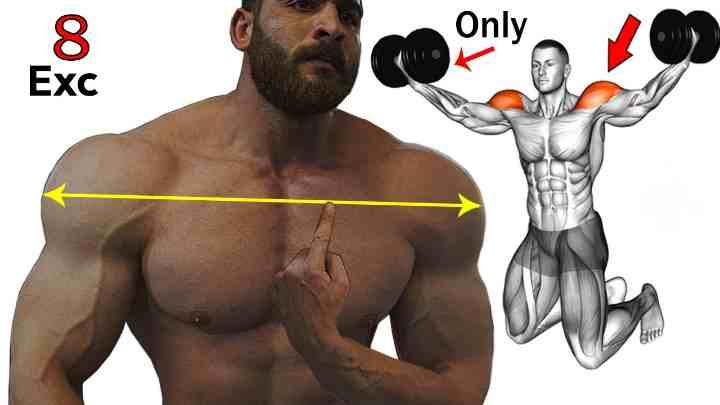If you’re looking to spice up your workout routine, the Dumbbell Around the World exercise is a fantastic choice! This fun and effective exercise helps strengthen your upper body while also improving your shoulder mobility. Whether you’re a beginner or a seasoned gym-goer, this exercise can easily fit into your fitness plan.
In this article, we’ll explore what the Dumbbell Around the World exercise is, how to do it correctly, and the many benefits it offers. Get ready to learn how to add this exciting move to your workouts and take your strength training to the next level!
How to Perform the Around the World Exercise?

To perform the Dumbbell Around the World exercise effectively, follow these steps:
- Starting Position: Stand with your feet shoulder-width apart, holding a dumbbell in each hand at your sides with palms facing your body.
- Lift and Circle: Raise the dumbbells in front of you, then move them in a circular motion. Lift them overhead, allowing them to touch above your head, and then lower them back down behind you to complete the circle.
- Controlled Movement: Ensure that the movement is smooth and controlled. Focus on using your shoulder muscles to create circular motion while keeping a slight bend in your elbows to avoid joint strain.
- Alternate Directions: After completing a set in one direction, switch and perform the movement in the opposite direction for balanced muscle engagement.
- Breathing: Inhale as you lift the dumbbells up and exhale as you bring them back down.
Targeting upper chest with pushups
This exercise primarily targets the shoulder deltoids while also engaging the core for stability. Start with lighter weights to maintain proper form and prevent injury.
Muscles Worked in Around the World Exercise
The Dumbbell Around the World exercise primarily targets several key muscle groups, making it an effective addition to upper-body workouts. Here’s a breakdown of the muscles worked during this exercise:
Primary Muscles Worked

- Pectoralis Major: This is the main muscle of the chest, responsible for actions like flexion and medial rotation of the shoulder joint. The Dumbbell Around the World effectively engages this muscle, promoting overall chest development.
- Deltoids: The shoulder muscles, particularly the anterior (front) deltoids, are heavily involved. While all three heads of the deltoids (anterior, medial, and posterior) contribute, the anterior deltoid is most active during the movement.
Secondary Muscles Worked

- Biceps: Although not the primary focus, the biceps assist in flexing the shoulders and stabilizing the arms during the exercise.
- Triceps: These muscles work in conjunction with the biceps to maintain arm rigidity throughout the movement, contributing to overall arm strength.
- Upper Back Muscles: Muscles such as the trapezius and rhomboids also engage to stabilize the shoulder blades during the exercise, enhancing upper back strength.
Core Engagement

- Core Muscles: The core muscles play a significant role in stabilizing the body as you perform this exercise. Engaging your core helps maintain balance and proper form throughout the movement.
Proper way to do dumbbell bench press
By targeting these muscle groups, the Dumbbell Around the World exercise not only builds strength but also improves shoulder mobility and stability, making it a valuable addition to any fitness routine.
Benefits of Around the World Exercise
The Dumbbell Around the World exercise offers several benefits that contribute to overall fitness and strength:

- Muscle Activation: This exercise significantly engages the pectorals and deltoids, improving muscle coordination and activation due to the need for stabilization throughout the movement.
- Improved Shoulder Stability: By promoting shoulder mobility and stability, it helps prevent injuries associated with shoulder impingement and enhances overall shoulder health.
- Functional Strength: The movement mimics real-life activities, enhancing functional strength that translates into daily tasks and athletic performance.
- Balanced Development: Using dumbbells allows each side of the body to work independently, promoting balanced muscle development and addressing any imbalances.
- Enhanced Core Engagement: The exercise requires core stability, which contributes to overall strength and stability in various physical activities.
- Joint-Friendly Movement: Dumbbells allow for a natural range of motion, reducing stress on the joints while effectively targeting the intended muscles.
- Versatility in Workouts: This exercise can be easily modified for different fitness levels and can be integrated into various workout routines for added variety.
How rear delts affect shoulder size
Incorporating this exercise into a workout routine can lead to improved upper body strength, better posture, and increased muscle definition.
Variations and Alternatives
When discussing variations and alternatives to the Dumbbell Around the World exercise, consider these options that can enhance your workout routine:
Variations of Dumbbell Around the World Exercise
- Standing Dumbbell Around the World: This variation focuses more on the deltoids. Stand with feet together, holding a dumbbell in each hand. Rotate your wrists to face forward, raise your arms to meet above your head, and lower them back to the starting position.
- Incline Dumbbell Around the World: Perform the exercise on an incline bench to target different angles of the chest and shoulders, increasing the challenge and muscle engagement.
- Dumbbell Fly to Press: This combines two movements: start with a dumbbell fly, then transition into a press. It effectively targets the chest from multiple angles and is great for hypertrophy training.
Alternative Exercises
- Dumbbell Flyes: A classic chest exercise that emphasizes stretching and contracting the pectoral muscles. Perform it lying on a flat bench while maintaining a slight bend in your elbows.
- Archer Push-Ups: A bodyweight alternative that targets the chest and shoulders, allowing for a greater range of motion and engagement of stabilizing muscles.
- Dumbbell Pullover: This exercise works both the lats and chest, providing a unique stretch and strengthening effect across the upper body.
- Devil’s Press: A full-body movement that combines a burpee with dumbbell overhead press, engaging multiple muscle groups including chest, shoulders, and core.
- Farmer’s Carry: While not directly targeting the chest, this exercise builds grip strength and overall upper body stability, which can benefit performance in other exercises.
Build strength in your front delts
By incorporating these variations and alternatives into your routine, you can keep your workouts fresh and continue to challenge your muscles effectively.
Common Mistakes to Avoid
When performing the Dumbbell Around the World exercise, avoid these common mistakes:
- Rushing the Movement: Many people perform the exercise too quickly, which can compromise form and reduce effectiveness. Focus on controlled movements to maximize muscle engagement and prevent injury.
- Using Excessive Weight: Lifting weights that are too heavy can lead to poor form and increase the risk of injury. Start with a manageable weight to ensure proper technique.
- Improper Arm Positioning: Ensure your arms are slightly bent throughout the movement. Locking out your elbows can strain your joints and reduce the effectiveness of the exercise.
- Neglecting Core Engagement: Failing to engage your core can lead to instability during the exercise. Keep your core tight to maintain balance and support your movements.
- Overextending Range of Motion: Lowering the dumbbells too far can put unnecessary strain on your shoulders. Maintain a range of motion that keeps your arms aligned with your torso to avoid overstretching.
By being mindful of these mistakes, you can enhance your performance and safety during the Dumbbell Around the World exercise.
Tips for Incorporation into Workouts
To effectively incorporate the Dumbbell Around the World exercise into your workouts, consider the following tips:
- Start with Light Weights: Use lighter dumbbells to ensure a full range of motion and to prevent shoulder strain. This exercise emphasizes control and technique over heavy lifting.
- Focus on Form: Maintain proper form throughout the movement. Keep a slight bend in your elbows, engage your core, and avoid shrugging your shoulders to prevent unnecessary tension in the upper traps.
- Controlled Movements: Perform the exercise at a steady pace, emphasizing smooth and controlled motions rather than speed. This approach enhances muscle engagement and reduces the risk of injury.
- Incorporate into Upper Body Routine: Use this exercise as part of your upper body workout, targeting shoulders, chest, and arms. It can be included in circuits or as a standalone exercise.
- Adjust Reps and Sets: Aim for 2-3 sets of 10-15 repetitions, adjusting based on your fitness level. Gradually increase weight as you become more comfortable with the movement.
- Alternate Directions: After completing a set in one direction, switch to the opposite direction to ensure balanced muscle development and improve shoulder stability.
- Listen to Your Body: Pay attention to how your body responds during the exercise. If you feel discomfort or pain, stop and reassess your form or consider reducing the weight.
By following these tips, you can effectively incorporate the Dumbbell Around the World into your fitness routine for enhanced upper body strength and mobility.

SHOP FOR THE ADJUSTABLE DUMBBELL SET ON AMAZON
FAQs
Q 1. Is the Dumbbell Around the World exercise suitable for beginners?
Ans. Yes, beginners can perform this exercise, but it’s important to start with light weights to ensure proper form and avoid injury. Gradually increase weight and repetitions as strength improves.
Q 2. What equipment do I need for this exercise?
Ans. You only need a pair of dumbbells. Choose lighter weights to allow for a full range of motion without straining your shoulders.
Q 3. How often should I incorporate this exercise into my routine?
Ans. For optimal results, include the Dumbbell Around the World exercise in your workout routine 1-2 times per week, allowing for recovery days in between.
Q 4. Can this exercise help with shoulder mobility?
Ans. Yes, the Dumbbell Around the World exercise is excellent for enhancing shoulder flexibility and stability due to its circular motion.
Q 5. Can I perform this exercise if I have a shoulder injury?
Ans. If you have any existing shoulder injuries, consult with a healthcare professional or physical therapist before attempting this exercise to avoid exacerbating your condition.
Conclusion
The Dumbbell Around the World exercise is a powerful addition to any fitness routine, offering a unique blend of strength training and mobility enhancement. By engaging multiple muscle groups, including the chest, shoulders, and core, this exercise not only builds upper body strength but also promotes better overall stability and flexibility.
As you incorporate the Dumbbell Around the World into your workouts, remember to focus on proper form to maximize benefits and minimize the risk of injury. Whether you’re a seasoned athlete or a beginner, this versatile exercise can be tailored to suit your fitness level, making it an excellent choice for anyone looking to elevate their training.

Good day, and welcome to Fitthour. My name is Shubham Vijay, and I am a certified personal trainer and nutrition coach with 6 years of experience in the fitness industry. At Fitthour, we specialize in types of training, such as strength training, cardio, or HIIT, and our mission is to help clients achieve their fitness goals and improve their overall health.



